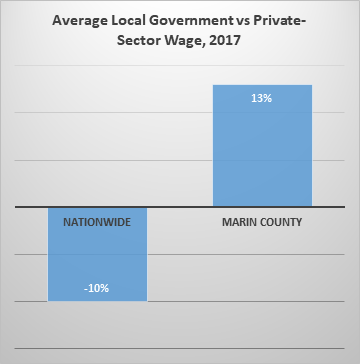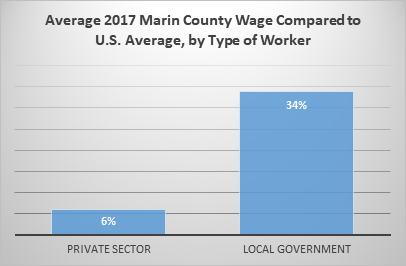Despite wages that rank in the top 1% nationwide, Marin union considers striking

Update: Strike was approved on 6/20/18.
The average wage for Marin County local government workers is richer than what their peers in 99.8 percent of counties nationwide receive, according to new wage data released from the federal Bureau of Labor Statistics (BLS) last week.
In 2017, local government workers in Marin County received an average annual wage of $76,138 — which ranked 6th out of the 2,867 counties surveyed nationwide, and was 53 percent higher than the $49,712 received by local government workers nationally.
Remarkably, even after accounting for regional cost differences among the 50 states, Marin County local government workers’ average wage still ranked firmly within the top 1 percent of counties nationwide, placing 8th out of the 2,867 counties surveyed.
Accounting for regional cost differences was achieved by adjusting the nominal wages received by each state’s 2016 Regional Price Parity, as calculated and reported by the Bureau of Economic Analysis.
For example, Marin County’s average was of $76,138 was reduced to $66,554 to account for average prices in California that were 14.4 percent above the national average, according to the BEA.
As indicated above, after a similar adjustment was made for all 2,867 counties nationwide, Marin County’s RPP-adjusted average wage for local government workers ranked 8th highest nationwide.
Government wages as % of private
In addition to outranking their local government peers in over 99 percent of counties nationwide, Marin County local government workers’ wages were significantly above average when measured against private-sector earnings.
Nationwide, average local government wages were 10 percent below private-sector workers. In Marin County, however, local government received an average wage that was 13 percent above what Marin County private-sector workers earned:

Similarly, while Marin County private-sector wages were 6 percent above private-sector wages nationally, Marin County local government workers’ wages were 34 percent higher than local government wages nationally:

Why government pay matters
Because employee compensation is by far the single largest category of government expenditures — accounting for nearly 70 percent of Marin County’s general fund budget — it is critical that taxpayers have complete and accurate information regarding the government pay packages that they are required to fund.
While the BLS data reflects all local government workers in Marin County and not just those employed by the County of Marin, it is nonetheless a strong indication that county wages are already at very competitive levels.
This is particularly true given the average $86,629 wage[1] received by County of Marin employees — excluding police and fire officers — was significantly above the $76,138 reported by the BLS for all local government workers in Marin County.
Beyond Wages
In addition to wages, compensation for Marin County employees includes employer-paid health and retirement benefits, paid leave, job security and retiree health benefits.
Because the terms of benefits vary by collective bargaining group, this analysis will focus solely on the Marin Association of Public Employees (MAPE) General Bargaining Unit, sometimes referred to as “rank-and-file” workers.
In addition to being Marin County’s largest bargaining group, an assessment of these workers overall compensation is particularly relevant given the union has called for a strike vote over allegedly insufficient pay.
Like all government workers, Marin County employees receive significantly greater levels of job security than their private-sector counterparts. Academic research has estimated the job security premium for California local government workers to be worth between 5 and 15 percent of wages.[2]
Marin County government workers also receive significantly richer amounts of all non-wage benefits than the average private-sector worker[3], as shown below:
|
Type of Compensation |
Average Private Sector |
Marin County Government |
Marin County Government vs Private |
|
Employer-Paid Retirement, as a Percent of Wages |
5% |
22% |
+320% |
|
Employer-Paid Share of Employee Medical Premium |
$5,310 |
$12,011 |
+126% |
|
Employer-Paid Share of Family Medical Premium |
$12,840 |
$18,843 |
+47% |
|
Paid Holidays |
7 |
14 |
+100% |
|
Annual Paid Sick Leave for 10+ year employees |
8 |
12 |
+50% |
|
Annual Paid Vacation Leave for 10-20 year employees |
17 |
20 |
+18% |
|
Annual Paid Vacation Leave for 20-30 year employees |
20 |
25 |
+25% |
The cause
Such outsized pay packages for California’s local government workers — and the burden they impose on the taxpayers who, on average, earn much less themselves — are the inevitable result of the state’s mandatory collective bargaining laws.
Because California state law forces local governments to bargain with a single government union, the union is able to wield this monopoly power to push labor costs well above market prices — a cost that is then passed on to captive taxpayers.
Adding insult to injury is the fact that these negotiations are done entirely in secret — ensuring that the taxpaying public is shut out of the process entirely.
Unsurprisingly, this arrangement has resulted in about $10 to $20 billion annually in added costs to California taxpayers, according to the most comprehensive study ever conducted on this issue by scholars at the Heritage Foundation.[4]
The current landscape is a result of the profound differences between unionization in the public and private sectors — which is why, historically, the idea of government unions was widely opposed by economists, policymakers and politicians on all sides of the ideological debate.
In addition to well documented opposition from traditionally pro-union policymakers such as President Franklin Delano Roosevelt, even labor unions themselves historically opposed the concept of unionizing government workers.[5]
For example, in 1955, AFL-CIO President George Meany said, “It is impossible to bargain collectively with the government.” Four years later, the AFL-CIO executive council passed a resolution declaring that, “In terms of accepted collective bargaining procedures, government workers have no right beyond the authority to petition Congress — a right available to every citizen.”[6]
So what changed?
As Geoffrey Lawrence and Cameron Belt document in The Rise of Government Unions: A review of public-sector unions and their impact on public policy, the shift towards favoring government unions didn’t occur because of any change in logic or analysis, but was simply the result of union bosses scrambling to find new dues-paying members in response to declining private-sector membership:
The American Federation of State, County, and Municipal Employees (AFSCME) was the first labor organization to explicitly acknowledge these points and to begin a systematic effort to bring compulsory collective bargaining to state and local governments. “Industrial unions seem to be at the end of a line…as more and more plants are automated,” and craft union membership “is growing only slowly,” the organization observed. “In public employment, however, there is an expanding reservoir of workers.”
While the original labor movement was created to prevent the exploitation of workers by profit-hungry corporations, no such justification exists for unionization in the public sector, which has neither owners nor profits over which to negotiate.
And because the government is funded via taxation, it faces none of the cost restraints found in the for-profit private sector. Private employers, on the other hand, are only able to generate revenue to the extent that consumers voluntarily purchase their goods or services.
Governments, by contrast, can finance above-market compensation by simply taxing the public. Most problematic is that the elected officials who approve these labor contracts bear none of the cost. In fact, these elected officials are routinely rewarded for doing so, as the concentrated political support bestowed upon them by appreciative government unions far outweighs the cost of taxpayers’ dispersed frustration.
On this point, Lawrence and Belt observe that:
Instead of resisting union demands, politician-employers have a keen interest in encouraging unionization among government employees because they can use government unions as political machines to secure election.
Thus, mandatory collective bargaining in the public sector has led to the very one-sided, exploitative arrangement that private-sector unions were originally designed to prevent — albeit with organized labor wielding the power, and the taxpaying public at large left largely powerless.
Given such a lop-sided power dynamic, it is little surprise that California’s public unions continue to push for more, despite already receiving compensation packages that, on average, significantly exceed market levels.
Illustrating the point
Despite belonging to the top 1 percent of counties with the highest-paid local government workers nationwide, in addition to receiving benefits that dwarf private-sector levels, the Marin County union (MAPE) recently rejected an across-the-board 7 percent pay raise over the next three years, and is demanding 11 percent instead (3.5 percent in FY19, 4 percent in FY20 and 3.5 percent in FY21).
It is worth mentioning that these across-the-board raises are on top of average yearly step increases of nearly 5 percent, which are available to employees who receive a “meets standards” or above assessment in their annual performance review and have not already reached the fifth step maximum.
So an employee still working their way up the step pay ladder would receive annual wage increases of roughly 7 percent under the county’s offer, and 8 to 9 percent under MAPE’s counter-offer.
As this example shows, government unions are not in the business of securing fair wages for workers who are being underpaid by profit-hungry employers. Instead, the incentives are such that most unions have one simple, unchanging goal: More.
Indeed, this approach is precisely what drove public compensation so far above market levels to begin with.
This is why, despite already having one of the highest tax burdens in the nation, municipalities across the state are seeking to raise that burden even further. And because the vast majority of these tax hikes — sales tax and fees for public services — are regressive in nature, it is precisely California’s lower- and middle-income residents who will fare the worst.
[1] Marin County Employees’ Retirement Association
Actuarial Valuation Report as of June 30, 2017.
[2] Jason Richwine and Andrew Biggs, “Are California Public Employees Overpaid?” The Heritage Center for Data Analysis, March 17, 2011.
[3] Employee benefits data for private-sector workers in not available on a state level, and thus this analysis uses national data for private-sector workers’ paid leave data and Pacific regional data for retirement and health benefits.
[4] How Government Unions Affect State and Local Finances: An Empirical 50-State Review, The Heritage Foundation, April 26, 2016.
[5] Cameron Belt and Geoffrey Lawrence, The Rise of Government Unions: A review of public-sector unions and their impact on public policy, Nevada Policy Research Institute.
[6] Ibid.
